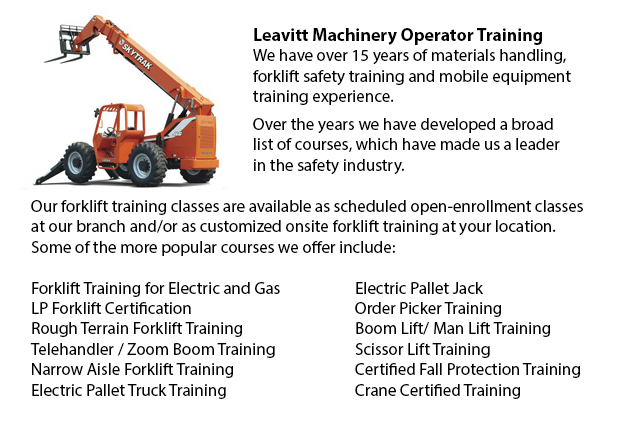
Telescopic Training Saskatchewan - The telescopic handler forklift is more often referred to as a telehandler, and is a machine which can lift products and materials to greater heights and has more versatility compared to a conventional forklift. It is usually preferred over the conventional masted counterbalance truck (standard and rough terrain). Whether utilized for transporting raw materials into the back of a dump truck or for transporting pallets within a warehouse, the telescopic forklift is an important equipment. Accredited telescopic handler training is essential to guarantee the safe and efficient operation of the unit.
A telescopic forklift is meant to lift heavy items using an arm, which extends in segments much like a telescope. To choose a telescopic forklift, you must take into consideration how the machinery will be utilized and for how long. Required lift heights and work site terrain must be considered. Parts, cost and warranty are all factors involved in purchasing a telescopic forklift. If you are leasing, you should compare terms, delivery costs and prices.
Telescopic forklifts are available in different sizes. Size influences the amount of weight that can be loaded onto the lift, and the heights which could be safely attained. A small- to medium-sized telescopic forklift is ideal for transporting supplies into the rear of a pick-up truck. Lifting heavier supplies up higher will require a bigger lift. Careful consideration of how the lift would be utilized helps ensures you would select the right size for stability and safety.
Attachments are one more consideration when choosing machinery. Ask what attachments are available from the manufacturer. There are bucket attachments, pallet attachments as well as various attachments used for particular purposes.
Work site terrain influences the variety of tires for the telehandler. Cushion tires are constructed of rubber all the way through, and are found on smaller units. Cushion tires are appropriate for telehandlers being used inside a warehouse with a concrete floor. They provide durability and stability. Pneumatic tires are often on larger units utilized on varied, outdoor terrain where there can be dirt, rock, concrete and asphalt. They provide the best traction and articulation.
-
Forklift Ticket Saskatchewan
Forklift Ticket Saskatchewan - Pallet jacks and forklifts are both meant for basically the same purpose; to move supplies from one location of your warehouse to another. This is pretty much where the comparison stops however. With the pallet jack, th... More -
Loader Ticket Saskatchewan
Loader Ticket Saskatchewan - Gehl articulated loaders have been made to suit practically any condition. They provide great traction and optimal maneuverability due to a heavy-duty oscillating joint that offers forty five degree rotating angles left a... More -
Forklift Training Programs Saskatchewan
Forklift Training Programs Saskatchewan - Are you searching for work as a forklift driver? Our regulatory-compliant mobile equipment operator training provides instruction in kinds of forklifts, pre-shift check, fuel kinds and handling of fuels, and... More -
Heavy Equipment Operator Classes Saskatchewan
Heavy Equipment Operator Classes Saskatchewan - A heavy equipment operator is an individual who has received the right training in order to operate a particular kind or piece of machinery. There are lots of ways for the operator to undergo training a... More -
Telehandler Training in Saskatchewan
Telescopic handlers usually known as telehandlers for short, are an extremely popular piece of heavy construction equipment. They are usually utilized in the construction and agricultural trades. These equipments have farthest reaching capacity and a... More -
Narrow Aisle Forklift / Order Picker Training / Electric Pallet Jack / Electric Pallet Truck Training in Saskatchewan
A pallet lift is a piece of equipment dedicated in the transporting of pallets of various dimensions and weights. They can be utilized as an attachment for forklifts, cranes and other types of heavy machinery or be applied on their own. Pallet lifts... More -
Operator Safety Training, Re-Qualification Training, In-House Instructor Training in Saskatchewan
Used in just about all industrial construction sites, warehouse operations or boat yards, the lift truck is a very important component so as to help pick up and transfer supplies. The reach feature of a forklift can help improve the applications whic... More -
Aerial Lift Ticket Saskatchewan
Aerial Lift Ticket Saskatchewan - Boom vehicle are often used by phone, cable and utilities firms as they have extended folded arms which are generally folded over the roofs of business vehicles. On the end of the extension of extendable arms usually... More

Forklift Training Saskatchewan
TOLL FREE: 1-888-254-6157
Saskatoon, Saskatchewan
forklifttrainingsaskatchewan.com
Email Us
About Us



